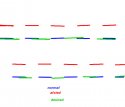magoo, I don't know what the emissions programming differences are between the countries but it would be interesting to know.
I see no reason to believe that the AF-XIED has anything to do with pinging on either bike you reference. And it is certainly unrelated to the blown engine, even that rider agrees that it didn't.
The AF-XIED does not affect the tune, period. It just lambda-shifts the input to the MM ECU with a completely normal looking signal. BTW, the LC-2 implementation used by several riders in this forum functions in the same way.
If you did attach a dual channel, scope with persistence so that you could watch the 2 second period of the O2 sensor waveform in closed loop you would see a waveform that looked identical but would be shifted in lambda. I have done this with a digitizing recorder to satisfy myself for the AF-XIED, LC-1 and LC-2.
Here's what you would see, working with the >700mV to <250 mV to >700mV normal stock narrowband O2 signal sequencing. For example, starting with the O2 sensor in a >700mV state, as the MM ECU reduces fueling to lean the mixture, the AF-XIED would get its signal to full lean sooner, signaling the MM ECU to start richening the mixture sooner. When the MM ECU tries to richen the mixture, it will take longer to get the AF-XIED to it's full rich >700mV state (so the O2 sensor get's to a rich state ahead of the AF-XIED. The waveform would look the same in both the stock and AF-XIED conditions, but the AF-XIED would be shifted forward in time. It does this using patented and patent-pending proprietary Digital Signal Processing algorithms.
So a simple description is the AF-XIED get to lean sooner (forcing more fuel) and then it takes longer to get back to a rich signal (also forcing more fuel). And remember, the amount of extra fuel is controlled and precise, unlike the EJK which forces Open Loop, and the PC which allows any amount of added fuel and which definitely messes with the tune.
I don't share your sentiments.
Below is a real crude sketch/graph of different signal the o2 may produce under the three conditions. It by no means is accurate, merely a representation of concept.
Blue being the stock, non altered o2, red being the amlituded shifted o2 of the afxied, and green the interval shifted signal. Both the red and green shifting produces an altered voltage, but the signals are completely different.
It is and has been my contention all along, that the narrow band o2 system reads the signal as an alternating current voltage, not a dc current voltage. The longer pulses of the green line never spike above the trigger voltages the ecu was programmed with at the factory. If those voltages spike, the ecu is going to detect a malfunction.
Imagine the red lines moving up and down as you adjust the afxied from the lowest setting, (closest to stock blue) and highest, moving up.
When the engine runs through the different rpm, the ecu will draw from the mapping programmed. If the mapping calls for more fuel, it will adjust based on the pulses given by the o2. The pulses, not voltage, is what the ecu reacts to. A longer duration, as in the desired (green), would be the proper signal for the ecu to receive, not a higher voltage of same duration.
As mentioned, both would produce a higher voltage average, but it is the pulse that is needed, not the voltage as a wideband o2 would need.
This picture is for visual only. It does not represent an actual scope reading in any way.

But it would be nice to think that the only thing affected by this sort of spoofing is the fuel. I just don't buy that. The MM ecu is advanced enough to also adjust timing for any number of conditions. If the signal is telling the ecu that the engine is performing in such a way that it needs more spark advance, it is going to advance the timing.
If that timing change is improper for the rest of the engine conditions, it could ping. Prolonged pinging can and will blow an engine. Carbon build in a high compression engine is also deadly.
TWO ozzie bikes...coincidence? These are not bmw, but TR650. These (TR650) are higher compression engines and different engine management than the BMW. And Oz tuning appears to be different as well, we know this because of de restriction etc. We don't do that stateside.



